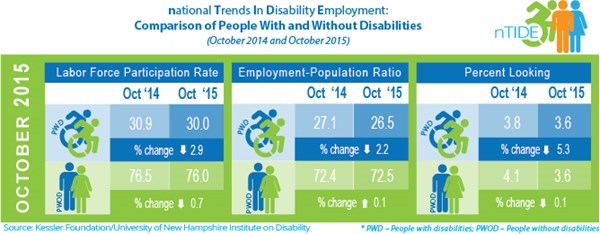WEST ORANGE, N.J., Nov. 6, 2015 (GLOBE NEWSWIRE) -- For the second consecutive month, Americans with disabilities are struggling to find employment, according to today's National Trends in Disability Employment – Monthly Update (nTIDE), issued by Kessler Foundation and University of New Hampshire's Institute on Disability (UNH-IOD). As the nation prepares to celebrate Veterans Day, the news underscores the need for initiatives that support hiring efforts for people with disabilities, including veterans.
In the Bureau of Labor Statistics' Jobs Report released Friday, November 6, the employment-to-population ratio for working-age people with disabilities decreased from 27.1 percent in October 2014 to 26.5 percent in October 2015 (down 2.2 percent; 0.6 percentage points). For working-age people without disabilities, the employment-to-population ratio slightly increased from 72.4 percent in October 2014 to 72.5 percent in October 2015 (up 0.1 percent; 0.1 percentage points). The employment-to-population ratio, a key indicator, reflects the percentage of people who are working relative to the total population (the number of people working divided by the number of people in the total population multiplied by 100).
"Similar to last month, we are not seeing improvement in the employment situation for people with disabilities," according to John O'Neill, Ph.D., director of employment and disability research at Kessler Foundation. "This is concerning, considering that over the first eight months of this year, we saw gains made by people with disabilities that actually outpaced those made by their peers without disabilities."
The labor force participation rate of people with disabilities also decreased from 30.9 percent in October 2014 to 30 percent in October 2015 (down 2.9 percent; 0.9 percentage points). For people without disabilities, the labor force participation rate also decreased from 76.5 percent in October 2014 to 76 percent in October 2015 (down 0.7 percent; 0.5 percentage points). The labor force participation rate is the percentage of the population that is working or actively looking for work.
"These numbers are not as severe as last month's numbers. Hopefully, the employment outlook for people with disabilities will return to what we saw earlier in the year," said Andrew Houtenville, Ph.D., associate professor of economics at UNH.
As Veteran's Day approaches, the nation is reminded of the challenges veterans face as they transition to civilian life and seek employment. Kessler Foundation awarded a grant to Easter Seals Greater Washington Baltimore Region to launch the Veterans Staffing Network (VSN)—a social enterprise employment agency for veterans, with and without disabilities, and their spouses. Recruiters and job coaches work with jobseekers to improve resumes, job skills, and interview preparedness. Federal regulations, such as Section 503 of the Rehabilitation Act, support hiring efforts as government contractors must make concerted efforts to have seven percent of their workforce comprised of individuals with disabilities, including veterans.
"So many veterans have real world skills that just don't easily translate, on paper, to many civilian jobs," said Larry Bram, senior vice president of innovation & program development at Easter Seals. "The aim of our program is to continually bridge this gap between employers and veteran job seekers. Federal guidelines advance our efforts as we help government contractors fill their hiring needs by employing qualified veterans with disabilities who are appropriate for each role."
In October 2015, among workers ages 16-64, the 4,173,000 workers with disabilities represented 3.0 percent of the total 140,979,000 workers in the U.S.
"The statistics in nTIDE are not seasonally adjusted," noted Dr. O'Neill. "Because disability employment data have been collected for so few years, more time is needed for seasonal trends to become evident."
The next nTIDE will be issued on Friday, December 4, 2015.
NOTE: The statistics in the National Trends in Disability Employment – Update are based on Bureau of Labor Statistics numbers, but are NOT identical. They have been customized by the University of New Hampshire to efficiently combine the statistics for men and women of working age (16 to 64).
nTIDE is funded, in part, by grants from the National Institute on Disability, Independent Living and Rehabilitation Research (NIDILRR) (H133B130015 & H133B120005) and Kessler Foundation.
About Kessler Foundation
Kessler Foundation, a major nonprofit organization in the field of disability, is a global leader in rehabilitation research that seeks to improve cognition, mobility and long-term outcomes, including employment, for people with neurological disabilities caused by diseases and injuries of the brain and spinal cord. Kessler Foundation leads the nation in funding innovative programs that expand opportunities for employment for people with disabilities. For more information, visit KesslerFoundation.org.
About the Institute on Disability at the University of New Hampshire
The Institute on Disability (IOD) at the University of New Hampshire (UNH) was established in 1987 to provide a coherent university-based focus for the improvement of knowledge, policies, and practices related to the lives of persons with disabilities and their families. For information on the NIDILRR-funded Employment Policy and Measurement Rehabilitation Research and Training Center, visit http://www.ResearchonDisability.org.
For more information, or to interview an expert, contact:
Lauren Scrivo, 973.768.6583, LScrivo@KesslerFoundation.org
Carolann Murphy, 973.324.8382, CMurphy@KesslerFoundation.org
A photo accompanying this release is available at: http://www.globenewswire.com/newsroom/prs/?pkgid=37431
